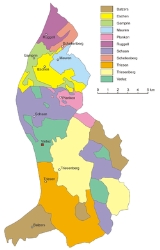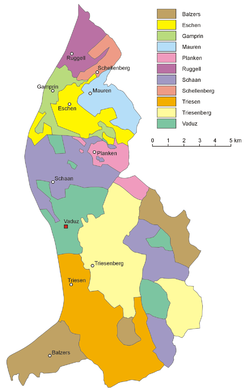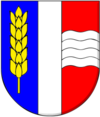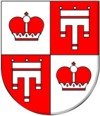
Municipalities of Liechtenstein
Encyclopedia
| |-
|-
|
The principality of Liechtenstein
is divided into eleven municipalities
(Gemeinden singular Gemeinde), most consisting of only a single town
. Five of the Gemeinden fall within the electoral district Unterland (lower country), the remainder are within Oberland (upper country).
Seven of the Gemeinden have one or more exclaves, in addition to the main territory:
, the codes of the municipalities
start with LI-, followed by two digits (01–11, assigned in alphabetical order).
In FIPS 10-4
(standard withdrawn in 2008), the codes of the municipalities started with LS-, followed by the same two digits as the ISO codes.
As a member of the EFTA
, Liechtenstein is included in the Nomenclature of Territorial Units for Statistics
(NUTS). The three NUTS levels all correspond to the country itself (NUTS-1: LI0; NUTS-2: LI00; NUTS-3: LI000). Below the NUTS levels, there are two LAU
levels (LAU-1: electoral districts; LAU-2: municipalities).

|
The principality of Liechtenstein
Liechtenstein
The Principality of Liechtenstein is a doubly landlocked alpine country in Central Europe, bordered by Switzerland to the west and south and by Austria to the east. Its area is just over , and it has an estimated population of 35,000. Its capital is Vaduz. The biggest town is Schaan...
is divided into eleven municipalities
Municipality
A municipality is essentially an urban administrative division having corporate status and usually powers of self-government. It can also be used to mean the governing body of a municipality. A municipality is a general-purpose administrative subdivision, as opposed to a special-purpose district...
(Gemeinden singular Gemeinde), most consisting of only a single town
Town
A town is a human settlement larger than a village but smaller than a city. The size a settlement must be in order to be called a "town" varies considerably in different parts of the world, so that, for example, many American "small towns" seem to British people to be no more than villages, while...
. Five of the Gemeinden fall within the electoral district Unterland (lower country), the remainder are within Oberland (upper country).
Municipalities
| Flag | Postal Code Postal code A postal code is a series of letters and/or digits appended to a postal address for the purpose of sorting mail. Once postal codes were introduced, other applications became possible.In February 2005, 117 of the 190 member countries of the Universal Postal Union had postal code systems... and Name |
Population (Dec. 31, 2005) |
Area in km² |
Towns |
|---|---|---|---|---|
| Electoral District Unterland | ||||
 |
9491 Ruggell Ruggell Ruggell is the most northerly and low lying of the Liechtenstein communities/municipalities, with population of 1,932 in 2007.-Overview:The name is said to be from the Latin for "clearing the land." Most known for conservation areas and the historic St... |
1925 | 7,4 | Ruggell |
 |
9488 Schellenberg Schellenberg Schellenberg is a municipality in the lowland area of Liechtenstein, on the banks of the Rhine. , it has a population of 952 and covers an area of .-Early history:... |
974 | 3,5 | Schellenberg |
 |
9487 Gamprin Gamprin -Overview:It contains Bendern which is among the most historic of Liechtenstein's communities. Lower Country men swore allegiance to the Prince in 1699 at Bendern. The community of Bendern also had ecclesiastical relevance going back to in least the fifteenth century. They have a church dedicated... |
1436 | 6,1 | Gamprin Bendern Bendern Bendern is a village of Liechtenstein, located in the municipality of Gamprin.... |
 |
9492 Eschen Eschen Eschen is a municipality in the north of Liechtenstein. As of 2005 it has a population of 4,150, and covers an area of 10.3 km². It is the fourth largest city in Liechtenstein.-External links:*... |
4076 | 10,3 | Eschen Nendeln Nendeln Nendeln is a village of Liechtenstein, located in the municipality of Eschen.-Geography:The village is located in north-central Liechtenstein, on the main road Schaan-Schaanwald that links the country with Buchs and Feldkirch... |
 |
9493 Mauren Mauren -History:It was first called "Muron" in documents from 1178. It has a memorial to the Liechtenstein educator and historian Peter Kaiser .-External links:**... |
3649 | 7,5 | Mauren Schaanwald Schaanwald Schaanwald is a village of Liechtenstein, located in the municipality of Mauren.-Geography:The village is located in north-central Liechtenstein, close to Austrian borders of Feldkirch, on the main road from Schaan that links the country with Buchs and Feldkirch... |
| Electoral District Oberland | ||||
 |
9494 Schaan Schaan Schaan is the largest municipality of Liechtenstein. It is located to the north of Vaduz, the capital, in the central part of the country. As of 2005 it has a population of making it the largest administrative district in Liechtenstein, and covers an area of 26.8 km², including mountains and... |
5811 | 26,8 | Schaan Mühleholz Mühleholz Mühleholz is a village of Liechtenstein, located to the south of Schaan along the Swiss border.... |
 |
9498 Planken Planken Planken is the least populated of Liechtenstein's municipalities. The entire community of Planken is estimated to have 366 people.-History:Its name is said to derive from a Latin word for rising meadows. Its most notable structure is an eighteenth-century chapel that was redesigned in 1955 under... |
366 | 5,3 | Planken Hinterschellenberg Hinterschellenberg Hinterschellenberg is a village of Liechtenstein, located very close to the Austrian border and belonging to the municipality of Planken.-Overview:... |
 |
9490 Vaduz Vaduz Vaduz is the capital of the principality of Liechtenstein and the seat of the national parliament. The town, located along the Rhine, has about 5,100 inhabitants , most of whom are Roman Catholic. Its cathedral is the seat of a Roman Catholic archbishop.... |
5047 | 17,3 | Vaduz Ebenholz Ebenholz Ebenholz is a village of Vaduz municipality in Liechtenstein, located in the center of the country, just in the north of Vaduz, between it and Schaan.... |
 |
9497 Triesenberg Triesenberg Triesenberg is a municipality in Liechtenstein with a population of 2,564. Its area of 30 square kilometers makes it the largest municipality in Liechtenstein. The center of the municipality rests at an elevation of 884-1,000 metres.-History:... |
2542 | 29,8 | Triesenberg Gaflei Gaflei Gaflei is a hamlet in Liechtenstein, located in the municipality of Triesenberg.-External links:* - description of Gaflei... , Malbun Malbun Malbun is a ski-resort village in the municipality of Triesenberg, Liechtenstein.-Geography:Malbun is the only resort for skiing in Liechtenstein. It is located at 5,200 ft above sea level in the Alps, on a road to Steg and Vaduz, and few kilometers from the Austrian border.... , Masescha Masescha Masescha is a village of Liechtenstein, located in the municipality of Triesenberg.... , Rotenboden Rotenboden Rotenboden is a village of Liechtenstein, located in the center of the country to the east of Triesenberg.... , Samina, Silum Silum Silum is a village of Liechtenstein, located in the municipality of Triesenberg.... , Steg Steg (Liechtenstein) Steg is a town in Liechtenstein, located in the municipality of Triesenberg.-Sports:Liechtenstein's only ski jumping hill is situated here.Steg is a popular destination for multi-sport.... , Sücka Sücka Sücka is a village of the municipality of Triesenberg, Liechtenstein, located just to the west of Rotenboden on the road to Steg and Malbun.... , Wangerberg Wangerberg Wangerberg is a village of Liechtenstein in the municipality of Triesenberg, located on a hill in front of Triesen.... |
 |
9495 Triesen Triesen Triesen is the third largest of Liechtenstein's municipalities. It contains several historic churches dating from the fifteenth century. It also has a weaving mill from 1863 that's considered a historical monument. The population is around 4,600.... |
4643 | 26,4 | Triesen |
 |
9496 Balzers Balzers Balzers is a village and community located in southern Liechtenstein. As of the 2005 census, the community has a total population of 4,420. The main part of the village is situated along the east bank of the Rhine.- History and Culture :... |
4436 | 19,6 | Balzers Mäls Mäls Mäls is a village of Liechtenstein, located in the municipality of Balzers.... |
| Liechtenstein Liechtenstein The Principality of Liechtenstein is a doubly landlocked alpine country in Central Europe, bordered by Switzerland to the west and south and by Austria to the east. Its area is just over , and it has an estimated population of 35,000. Its capital is Vaduz. The biggest town is Schaan... |
34905 | 160,0 | ||
Exclaves and Enclaves
The municipalities of Liechtenstein, the Gemeinden, exhibit complex shapes, despite their small size.Seven of the Gemeinden have one or more exclaves, in addition to the main territory:
- Balzers: 2 exclaves
- Eschen: 2 exclaves
- Gamprin: 1 exclave
- Planken: 3 exclaves, 1 enclave
- Schaan: 4 exclaves, 2 enclaves
- Triesenberg: 1 exclave (around the town of Malbun)
- Vaduz: 5 exclaves
Data codes
In ISO 3166-2ISO 3166-2
ISO 3166-2 is part of the ISO 3166 standard published by the International Organization for Standardization , and defines codes for the names of the principal subdivisions of all countries coded in ISO 3166-1...
, the codes of the municipalities
ISO 3166-2:LI
ISO 3166-2:LI is the entry for Liechtenstein in ISO 3166-2, part of the ISO 3166 standard published by the International Organization for Standardization , which defines codes for the names of the principal subdivisions of all countries coded in ISO 3166-1.Currently for Liechtenstein, ISO 3166-2...
start with LI-, followed by two digits (01–11, assigned in alphabetical order).
In FIPS 10-4
FIPS 10-4
The FIPS 10-4 standard, Countries, Dependencies, Areas of Special Sovereignty, and Their Principal Administrative Divisions, lists two-letter country codes that are used by the U.S. Government for geographical data processing in many publications, such as the CIA World Factbook. The standard is...
(standard withdrawn in 2008), the codes of the municipalities started with LS-, followed by the same two digits as the ISO codes.
As a member of the EFTA
European Free Trade Association
The European Free Trade Association or EFTA is a free trade organisation between four European countries that operates parallel to, and is linked to, the European Union . EFTA was established on 3 May 1960 as a trade bloc-alternative for European states who were either unable to, or chose not to,...
, Liechtenstein is included in the Nomenclature of Territorial Units for Statistics
Nomenclature of Territorial Units for Statistics
The Nomenclature of Territorial Units for Statistics or Nomenclature of Units for Territorial Statistics is a geocode standard for referencing the subdivisions of countries for statistical purposes...
(NUTS). The three NUTS levels all correspond to the country itself (NUTS-1: LI0; NUTS-2: LI00; NUTS-3: LI000). Below the NUTS levels, there are two LAU
Local administrative unit
Generally, a local administrative unit is a low level administrative division of a country, ranked below a province, region, or state. Not all countries describe their locally governed areas this way, but it can be descriptively applied anywhere to refer to counties, municipalities, etc.In the...
levels (LAU-1: electoral districts; LAU-2: municipalities).
External links
- Communes of Liechtenstein, Statoids.com

